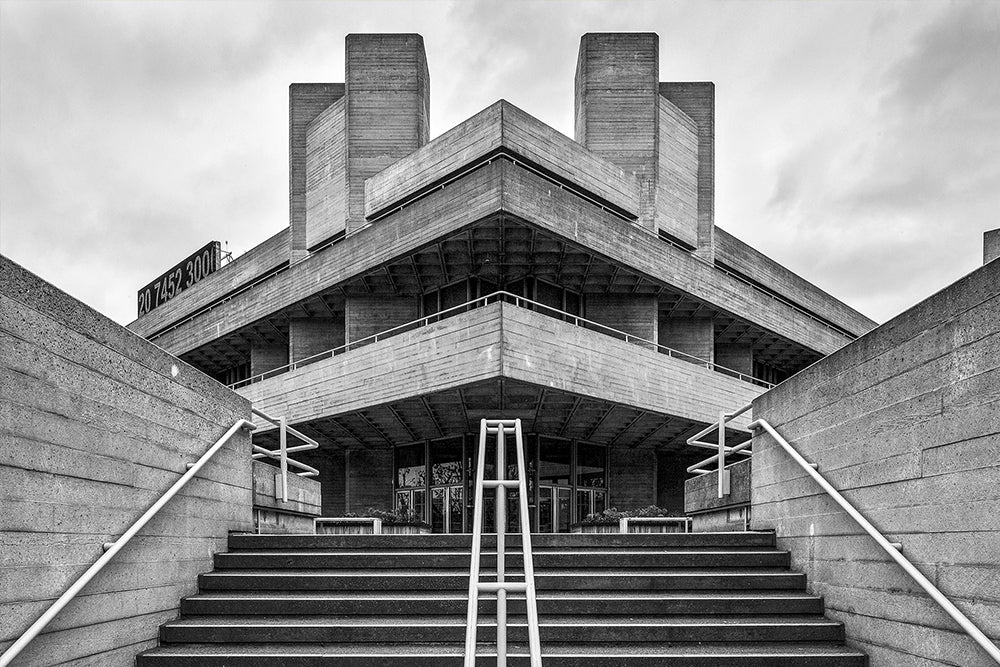
Heritage, demolition and sustainability: Understanding Brutalist architecture in London today
Share
With the second edition of our Brutalist London Map now published, join us on the journey of Brutalist architecture in London from the 1950s to today with Henrietta Billings, the map's editor and the director of SAVE Britain’s Heritage. Here she explains how the movement travelled from optimism to controversy, to heritage value and the new meaning of concrete buildings today in an era of climate change. (All photography by Simon Phipps.)
Our collection of Brutalist titles and features are all available to purchase and read here.
What did Brutalism as a style represent for London during the 20th century?
When Brutalism burst on the scene in the 1950s it represented power, swagger, and a desire for architecture to be a strong statement. An optimism about a new way of living, a change of direction for public building, a lack of compromise and a lot of concrete. It was ground-breaking for public buildings – including substantial housing projects – and its relatively short-lived period ended with un-popularity and some would say unfair malign. It was also to prove highly controversial.

Brunswick Centre, Patrick Hodgkinson, 1966-71. Photography: Simon Phipps
From the soaring towers of the Barbican, to the daring structures of the Brunswick Centre, historically low oil prices made mass concrete and steel possible for large scale public building projects – any shape and size of construction became possible. Concrete was functional and affordable and its use flourished in the 1950s through to 1970s as Britain was re-built after the war. And as local authorities experimented with bold concrete forms for the first time, there were inevitable problems with the construction process that obscured the merits of the buildings.
The 31-storey Trellick Tower in West London, for example, was once dubbed the “Terror Tower”, and stories of broken lifts, crime, and squalid conditions were rife. At one point it was dubbed the ugliest building in England and its architect Erno Goldfinger widely derided. Much of the blame for these failings has since been laid at the door of maintenance and management rather than the architecture itself. Today it is revered as an iconic monument of Brutalism and 1960s design – a magnet for architecture students, designers, tourists and architectural historians. It’s a useful reminder of how architectural fashions and trends change over time.
What does Brutalism represent for the city today?
Brutalism represents a crucially important snap shot in the history of London and its people – and of course it’s not just restricted to the capital. It’s interesting because of the values and hopes it represents – and because it was so relatively short-lived. It represents a moment of unprecedented construction built with energy guzzling materials on a scale that will never be repeated.
Brutalism is enjoying a resurgence of interest and study – with striking silhouettes of iconic structures emblazoned across t-shirts, tote-bags and tea towels to mugs, prints and soft cushions. Yet it is not universally loved. Demolitions over recent years like Robin Hood Gardens, or the Welbeck Street Car Park show that despite its rise in popularity, it is still vulnerable.
Robin Hood Gardens, Alison and Peter Smithson, 1972. Photography: Simon Phipps
What has changed on the map since it was published in 2015?
Sampson House on the banks of the Thames has been demolished, as has Keybridge House – a landmark on South Lambeth Road. Coralline Walk, Thamesmead has also been lost. Half of Robin Hood Gardens by Alison and Peter Smithson has been demolished – with the rest set to follow – and a three storey chunk of the structure acquired by the Victoria and Albert Museum. On a more positive note, the Brixton Rec has been listed at Grade II, and so has Acland Burghley school, designed by Howell, Killick, Partridge and Amis – right next to Tufnell Park tube. The 1970s Camden Town Hall Annexe on the Euston Road has also been successfully converted and transformed into The Standard Hotel.
Since the last edition we’ve also added the National Archives at Kew, opened in 1977 and not listed. Another addition is the Grade II* listed British Rail Maintenance Depot in Paddington, built in 1966-68 and clad in mosaic tiles, and the Blackheath Meeting House by Trevor Dannett and Partners. We’ve included Haggerston Girls School, designed by Erno Goldfinger, The Royal College of Art building on Kensington Gore and others.
Brutalist London Map is one of many London titles published by Blue Crow Media. Available as a discounted set here.
Which buildings on the map are under threat?
The Southbank Centre remains vulnerable due to repeated refusals to list the 1960s arts complex. Ashington House has a certificate of immunity from listing – meaning it can’t be considered for listing again until 2024 and is therefore vulnerable to redevelopment. Basil Spence’s Hyde Park Barracks are still not listed thanks to a ministerial decision, despite an application from the Twentieth Century Society and a recommendation for Grade II listing from Historic England, the government’s heritage advisers.
Which would you say is the most radical Brutalist building on the map and why?
All of the buildings on this map are radical – and two stand out for me. Neave Brown’s Alexandra Road estate and William Whitfield’s extension for the Chartered Accountants in The City.
Neave Brown’s Alexandra Road estate is widely regarded as one of the finest public housing schemes in Europe. When it was listed in 2004, it was the youngest, and first post-war housing estate to be designated. It covers nearly 7 hectares, including 520 homes, a school, 2 care homes, shops and pub and a community centre. The stepped sections, traffic free streets, lush planting and underground parking make it one of the UK’s most significant urban landscapes.
The other is Chartered Accountants Hall Extension, built in 1966-70. William Whitfield’s daring 20th century addition to the earlier 19th century institution is an impressive composition of contrast and complement, which must have raised eyebrows when it opened in the City of London. John Belcher’s imposing and ornate 1890s Portland Stone clad building contrasts beautifully with Whitfeld’s Brutalist composition of block forms in concrete. The sculptures that enrich the elevations on the facades of the Victorian hall are complemented by the sculptural bush hammered concrete of Whitfield’s extension. The building is listed at Grade II * with the quality of materials and craftsmanship of the twentieth century additions given special mention in the listing description. Whitfield’s other notable (not Brutalist) building in London is his later 1980s Richmond House on Whitehall, the subject of a recent successful campaign by SAVE Britain’s Heritage to save from major demolition.
Which would you say is the most successful Brutalist building on the map and why?
It depends how you define success, but without doubt one of the most well-loved, well crafted and impressive public buildings in the brutalist style is the National Theatre on the bank of the Thames. The exquisite quality of the concrete effortlessly rebuffs the doubters who call concrete cheap and poor quality. The fact that it remains in use as a theatre – since it opened in 1976, is testament to its cultural and commercial success. It has played a lion’s share in helping to change perceptions of Brutalism by being timeless in its design, and looking sleek, and enduringly cool. It’s a joy to visit and spend time in.

National Theatre, Denys Lasdun, 1976. Photography: Simon Phipps
What do you personally think of Brutalist architecture as a style visually and conceptually? What do you like about it? Or perhaps you have some problems with it?
Brutalist architecture is exciting, vast, sculptural and tactile. I love the combination of a simple palette of raw materials, together with vast forms and daring structures. I like the way the architects chose to dazzle and shock by presenting the previously hidden guts of the structures and the unpainted smooth and rough finishes. I admire the optimism and short-lived vision that building with such cheap, and energy guzzling materials offered. These buildings are part of our 20th century legacy. In 2022, seven years on from the first edition of the map, the environmental impact of demolishing these buildings and their vast stores of embodied carbon is alarmingly clear. From a sustainability as well as a heritage perspective, we cannot afford to lose any more of them.
Interested to discover more about this topic? Blue Crow Media’s Brutalist London Map is researched and written by Henrietta Billings, with the support of the 20th Century Society, and includes photography by Simon Phipps.
The map is available to purchase from a variety of bookstores across London and directly from our website.


